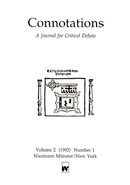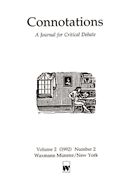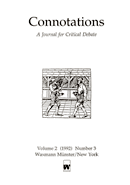Connotations Vol.2
(1992)
Articles in this issue
- The Pivotal Position of Henry V in the Rise and Fall of Shakespeare's Prose
Robert Crosman, 2.1:1-15. - Multiplicity of Meaning in the Last Moments of Hamlet
John Russell Brown, 2.1:16-33. - From Etymology to Paronomasia: Wallace Stevens, Elizabeth Bishop, and Others
Eleanor Cook, 2.1:34-51. - A Complementary Response to Anthony Brian Taylor, "Arthur Golding and the Elizabethan Progress of Actaeon's Dogs"
Charles Martindale and Sarah Annes Brown, 2.1:58-68. - Actaeon's Dogs in Ovid's Metamorphoses, and the Wolf Pack in Ysengrimus
F. J. Sypher, 2.1:52-57. - A Comment on Roy Battenhouse, "Religion in King John: Shakespeare's View"
Christopher Z. Hobson, 2.1:69-75. - A Response to Matthias Bauer, "Count Malvolio, Machevill and Vice"
J. J. M. Tobin, 2.1:76-81. - Towards Tolerant Pluralism in Renaissance Drama Studies (An Answer to William W. E. Slights)
Brownell Salomon, 2.1:82-85. - The Malcontent Redux: A Response to Brownell Salomon and William W. E. Slights
Edmund M. Taft, 2.1:86-92. - Puzzling Marston and Homer (A Response to Brownell Salomon and William W. E. Slights)
Joseph A. Porter, 2.1:93-96. - A Letter in Reply to Joseph A. Porter
Brownell Salomon, 2.1:97. - One Constructed Reading Self after Another (A Response to Thomas F. Merrill)
Harold R. Swardson, 2.1:98-102. - Inventional Mnemonics and the Ornaments of Style: The Case of Etymology
Mary Carruthers, 2.1:103-14. - Paronomastics: The Name of the Poet from Shakespeare and Donne to Glück and Morgan
William Harmon, 2.2:115-25. - "Single Nature's Double Name": Some Comments on The Phoenix and Turtle
Christiane Gillham, 2.2:126-36. - Reader Participation and Rationalism in Fielding's Tom Jones
Lothar Černý, 2.2:137-62. - A Response to F.J. Sypher
Anthony Brian Taylor, 2.2:163-65. - Reflections in Response to Sandra Billington, Mock Kings in Medieval Society and Renaissance Drama
Clifford Davidson, 2.2:166-71. - On King John: An Answer to Billington and Hobson
Roy Battenhouse, 2.2:172-81. - Hamlet's Last Moments: A Note on John Russell Brown
Dieter Mehl, 2.2:182-85. - The Rest Is Not Silence: A Reply to John Russell Brown
Maurice Charney, 2.2:186-89. - A Constructed Reading Self Replies
Thomas F. Merrill, 2.2:190-94. - A Response to Alan Rosen, "Plague, Fire, and Typology in Defoe's A Journal of the Plague Year"
Josef Haslag, 2.2:195-200. - In Reply to Eleanor Cook, "From Etymology to Paronomasia"
Anthony Hecht, 2.2:201-04. - Lively, Dynamic, but Hardly a Thing of "rhythmic beauty": Arthur Golding's Fourteeners
Anthony Brian Taylor, 2.3:205-22. - Paronomasia in the Quip Modest: From Sidney to Herbert
Judith Dundas, 2.3:223-33. - The Seasons of the Globe: Two New Studies of Elizabethan Drama and Festival
Thomas Pettitt, 2.3:234-56. - A Comment on Robert Crosman, "The Pivotal Position of Henry V in the Rise and Fall of Shakespeare's Prose"
Stanley Hussey, 2.3:257-62. - Hal, Falstaff, Henry V, and Prose
Jonas Barish, 2.3:263-68. - Maria's Riddle
Alastair Fowler, 2.3:269-70. - A Note in Reply to Alastair Fowler
Matthias Bauer, 2.3:271-74. - Connotations of Hamlet's Final Silence
John Russell Brown, 2.3:275-86. - A Comment on the Naming of Characters in The Winter's Tale
Kenneth Muir, 2.3:287-90. - An Answer to Kenneth Muir
Inge Leimberg, 2.3:291-94. - From Paronomasia to Politics in the Poetry of Stevens and Bishop: A Response to Eleanor Cook
Jacqueline Vaught Brogan, 2.3:295-304. - In the Line of Wit: A Response to Eleanor Cook
Anca Rosu, 2.3:305-312.


